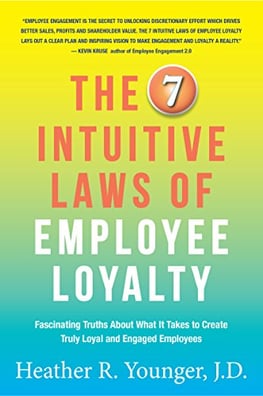📖 Applauz Book Club is a series that outlines noteworthy ideas from popular books on the topics of work, HR strategy, and management.
Every organization wants engaged employees.
Employee engagement has become an essential part of modern HR practice. The term and concept are now prevalent.
In response, an abundance of information and research on the topic has emerged.
In other words, articles on employee engagement are easy to come by. But as you read about the topic, you'll notice many of the same ideas and tactics appearing everywhere.
For example:
- Offering flexibility & greater work-life balance
- Professional growth opportunities
- Giving employees autonomy
- Developing a meaningful mission
While there is no shortage of knowledge available on what drives employee engagement, many organizations STILL struggle with keeping employees happy and engaged.
Where is the problem?
A major shortcoming with standard employee engagement advice is that it's conceptual.
For example, an article will claim that "supporting mental health" is critical to employee engagement. Yet, it will only touch the surface of how organizations can achieve this goal. In other words, there’s a lack of concrete and practical tactics available.
goal. In other words, there’s a lack of concrete and practical tactics available.
An in-depth look at what drives employee loyalty
We selected the 2017 book The 7 Intuitive Laws of Employee Loyalty as a key reading for HR professionals because the book is concise, easy to read, and packed full of value.
Through a series of stories and case studies, the author breaks down what leaders and companies need to do to engage and retain their employees.
The author goes beyond superficial ideas. Detailed recommendations are provided on how these engagement tactics can be implemented.
That said, Younger is not new to the field; she is an expert in human resources. She is the CEO and founder of Customer Fanatix. A consulting organization with a mission to train leaders and help organizations with strategies to improve employee engagement.
She has been writing about employee engagement, work, and people management for many years. And The 7 Intuitive Law of Employee Loyalty is peppered with quotes from readers of her articles. Quite often, these comments are candid, giving us an unfiltered view of employee opinions and psychology.
The 7 laws outlined
In this instalment of Applauz Book Club, we will outline the first five of the seven laws of employee loyalty.
-
Give them great supportive managers
-
Recognize employees often
-
Give them a voice and do something about it
-
Grow and promote their talents
-
Foster deep connections with them
-
Make teamwork the focus
-
Pay them equitably
You can purchase the book if you're interested in learning more after reading this article.
That said, after reading this book, you will:
- Learn fundamental principles of what it takes to retain top talent. As the author points out, this doesn't necessarily mean you will keep them forever, but longer than they would have stayed initially. And most importantly, turn them into brand enthusiasts who will recommend your company as a great place to work.
- Clarify how your beliefs and actions play a role in creating an engaging workplace that attracts and keeps the best people.
- Motivate yourself to follow through with some of the steps in this book.
The 7 Intuitive Laws of Employee Loyalty

LAW 1 - Give them great supportive managers
People don't leave jobs; they leave managers.
We've heard it so many times that it's become trite to mention. Nonetheless, the chapter on the importance of supportive managers is the first and most important chapter in Younger's book.
According to Younger, "none of the other laws matter if organizations don't abide by the laws of leadership."
Younger goes on to describe what entails great management. And not in a vague, conceptual way. Instead, she gives concrete examples of how managers can rise and provide employees with essential support. The kind that will keep them happy and engaged.
We'll go over a few of the key points outlined in the chapter.
Put their needs above your own: Younger affirms the worst managers "are those with a tremendous amount of ego." On the flip side, the best leaders "have a sense of selflessness and a need to bring out the best in others." Great managers show employees they care not only with words but with actions. For example, by letting them know you are interested in them outside of what they do for the company or actively helping them move up the career ladder. Younger warns, very few employees will remain loyal to you if you are not loyal to them.
Initiate consistent professional development talks: By taking an active role in career development, you show employees you are interested in their future. According to Younger, "this is hugely meaningful to anyone who is on the other end." For example, this may mean discussing a potential shift out of your department. Even if they do not pursue that path, your employee will respect and admire you even more for going down that road with them.
Be humble: Many leaders tend to get a little stuffy once in a while. Still, Younger warns that placing yourself above your team is a sure way to alienate them. Younger suggests maintaining a "heightened awareness" of your presence and paying attention to whether people are coming towards you or avoiding you. Be more deliberate in your humility. Employees will feel more connected to you and, ultimately, your organization as a result.
LAW 2 - Recognize your employees often
Recognition is the number two law outlined in this book. It's at the top of the list because appreciation is critical to employee engagement. Research shows that 79% of employees who leave their jobs cite a lack of recognition as the main cause for their departure.
We know recognition is necessary, but many companies go about it the wrong way. Younger insists that giving everyone a ribbon or only recognizing rock stars (and leaving others out) is not the way to recognize them.
All your employees want to be recognized. However, it's crucial to keep in mind not everyone wants to be recognized in the same way.
Younger illustrates her point by describing the work of psychologist David McClelland, an expert in employee motivation.
There are three primary types of employee motivation. Through this framework, it is possible to reward employees in a way that speaks to their unique motivations.
- Achievement Seekers: These employees are motivated by achievement. They are driven by success and a desire to grow and improve continuously. As such, they want to be recognized with financial rewards and positive praise and feedback.
- Authority Seekers: These employees love having their ideas being heard. The most important recognition method for them is being promoted into a higher position of authority or being given more responsibility. They are motivated by increasing personal status and influence.
- Affiliation Seekers: These employees are motivated by forming connections with the people they work with. Recognize this group by allowing them to lead committees of workers with common goals.
Make sure to understand what group your employees fall into before you formally reward or recognize them. Bottom line: Get to know what motivates your employees and what makes them feel recognized and valued at work.
When it comes to more informal and spontaneous recognition, Younger speaks on the importance of crowdsourcing recognition.
The concept of crowdsourcing means creating a recognition program where peers or customers are given a platform to communicate their appreciation to employees.
Having a system like this in place will relieve managers from having to do all the recognition. Younger states, "hearing praise from others outside of that employee-manager relationship can be all the difference between an employee feeling valued and not feeling valued at all.
LAW 3 - Give them a voice and do something about it
Younger insists “employees feel valued and successful when they feel their voice is heard.” But most importantly, when their voices “lead to positive change.”
Simply put, listening to employees (and acting on their feedback) is central to employee engagement.
Every business needs an employee listening strategy.
This plan of action must always start by asking yourself, “why are you listening.” Knowing the “why” will help everything else fall into place.
Younger explains the most important methods for employee listening. The tactics proposed in this chapter go beyond the classic yearly engagement surveys.
Other popular methods of gathering feedback include:
-
Manager meetings
-
All employee meetings
-
Focus groups
-
1:1 interviews
-
Employee happiness audits
-
Stay interviews
Once you have gathered your employee insights, the next step is to put some of these ideas into action. This is the most important part and also the most difficult for many HR teams. However, Younger offers some suggestions.
- Rally the team: Establish a “governing body” to review the feedback and decide what themes get fixed or acted upon.
- Who is accountable to act: Pick a stakeholder who is responsible for acting on the feedback.
- Track improvements: Come up with a plan for how you will measure and track the improvements.
Younger understands how easy it is to describe this process in words. In other words, listening to employees and taking action on their feedback is much more complex in action than it is on paper.
She closes this chapter by explaining three main reasons why businesses fail at their employee listening efforts:
- They don’t want to know: Many companies don’t seek employee input. They believe the front-line employee won’t bring value to the conversations. Younger warns this mindset can be “potentially deadly to any company looking to grow and retain great talent.”
- They lack clear direction and process: Making employee listening a strategic priority means having a framework or clear processes for receiving and responding to feedback.
- They don’t have the resources to follow through on the next steps: Many companies want to listen to employee feedback. Yet, they don’t go forward with it or act on feedback simply because they lack the resources needed to respond.
LAW 4 - Grow and promote their talents
Younger starts off this chapter by proclaiming, “There are so many hidden gems within your workforce.” When organizations fail to find those gems, they will lose in the talent acquisition and retention rate.
Any HR professional can agree, career growth and development are key for improving employee retention. Nevertheless, research shows that many companies are lousy at providing employees with opportunities to grow their skills and careers.
In an Employee Engagement Report by TinyPulse, only 26% of employees felt that their employer provided them with adequate opportunities for professional development
When employees lack growth opportunities, it’s often caused by three reasons:
- They are too siloed or not given any new projects to work on or given chances to expand their skills.
- There is no discussion of career development.
- They have background skills or knowledge that is not being used.
Younger explains why many businesses fail at developing their talent.
Murky career development paths are at the root of the problem. Simply put, most employees don’t have concrete ideas of how to get promoted.
The solution: Businesses must define and document clear growth paths for their employees.
Practically speaking, this initiative starts with HR or company leaders defining specific targets employees need to achieve in order to progress in the company.
In this chapter, Younger includes an interview with a talent development leader at Zappos, a company known for its strong culture and talent development. The interview outlines how Zappos defines clear growth paths for employees and other talent development strategies used to nurture and retain its best people.
That said, it is not always possible for each employee to advance to a new role. Nonetheless, businesses should strive to develop their employees continuously, to challenge them and grow their skill set in their current role.
Younger finishes off the chapter by providing readers with some creative ideas to achieve just that.
For example:
- Mentor programs: Invest in a program that matches more senior leaders with newer employees. Or any employee (no matter what the tenure) who simply wants to move to a new place in their career.
- Job-shadowing: Set up an environment where employees can visit other departments to see what they do.
- Talent mobility: Focus on putting people in the right places when they are needed and based on their skill-set.
LAW 5 - Foster deep connections with them
Human connection is something we all seek not only in our personal lives but also at work. That’s why Younger encourages leaders to cultivate authentic relationships with their employees.
No one wants to “feel like a number,” she says. It's the “longing for connection that pushes employees to move from workplace to workplace.”
Connections start with a clear and inspiring mission and vision.
As Younger puts it, “being clear about where you are going, how you intend to get there, and how the individual on your team will contribute to the journey.”
Many organizations struggle to cultivate strong cultures because they look to short-term ideas like free food and other surface-level tactics. Or worse, many business leaders overlook the signs that their culture might be failing.
For example:
- Employees lack trust in management.
- Employees are not feeling valued.
- People are misaligned and working towards competing goals.
Organizations that are renowned for their thriving cultures do not “leave it to chance.” They are deliberate and “do a culture on purpose.”
Younger offers some ideas on how companies can build more intentional cultures.
- Take time to figure out what type of company you want to be, for example, by determining the non-negotiable components of your culture.
- Include many people in the planning. Gather feedback from managers and seek front-line input. Everyone needs to be vested in this new direction.
- Research organizations that you admire. Allow other organizations’ success to help build your own vibrant culture.
- Make hard decisions that focus on the good of the whole. An example of this might be removing a leader from the organization because he or she is thwarting transformation.
The bottom line, people want to make a difference. We all want to feel that our work contributes to something bigger and more meaningful. Intentionally building and reminding people of that vision will help your business retain talent in the long run.
Final Thoughts
In closing, Younger makes an impactful statement:
"Remember, people are loyal to the people inside of organizations. They are not loyal to buildings or legal entities."
According to Younger, meaningful work and connections drive our emotional attachment to a workplace, and by extension, our loyalty.
Younger made this statement in 2017, in a pre-pandemic world. But this sentiment is even more true in 2021, a time where employees are even more discerning.
In other words, we live in a world where people have more choices than ever before. Companies that deliberately build healthy cultures and take genuine care of their employees will ultimately come out on top.
About the author
 Michelle Cadieux
Michelle Cadieux
Michelle is a content writer for Applauz. She holds a Bachelor's degree in Psychology from Concordia University, and she has been writing about work and employee happiness for over five years.




